yoga nidra for sleep: unlocking the power of deep sleep

Yoga nidra for sleep | Yoga practice is often associated with effortful yoga postures, sweaty yoga mats, and stretchy pants that cost their weight in gold. But what if you could practice a style of yoga that doesn’t even require you to get out of bed?
No pants, no poses, no problem.
And speaking of doing yoga in bed, what if this style of yoga practice could massively improve your life by training you to get regular and deep relaxation, improve your sleep onset (ability to fall asleep), and improve the quality of your sleep by helping you sleep longer and deeper?
What if there was a practice that could help you establish a healthy sleep routine so you could enjoy life feeling energized, alert, and ready to take on your day?
Enter Yoga Nidra for Sleep. (Take my online course here)
Table of contents
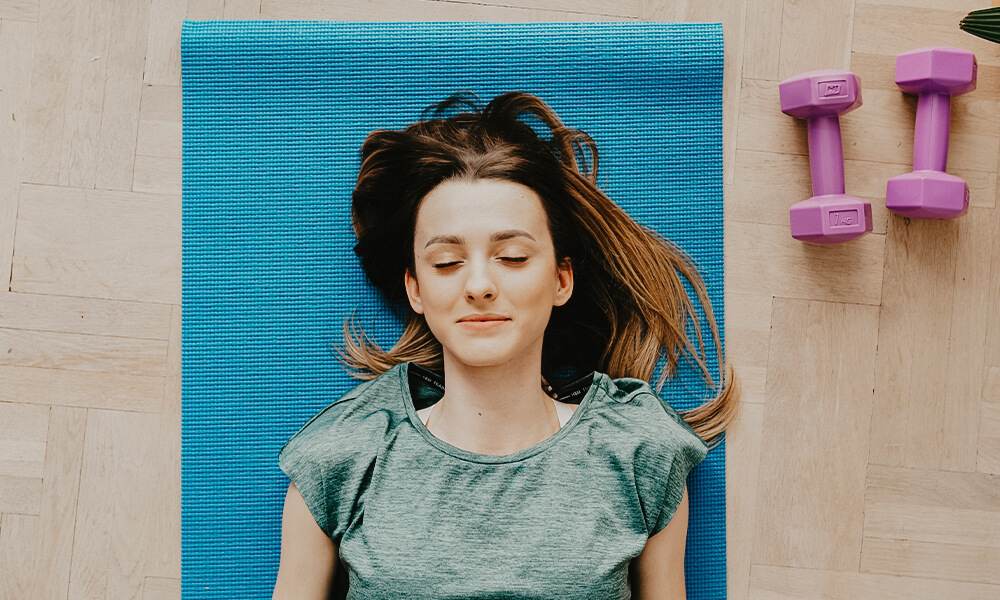
Key Takeaways:
- Yoga Nidra, an ancient practice: Yoga Nidra, also known as “yogic sleep,” is an ancient practice that combines deep relaxation with conscious awareness to promote a state of restful meditation.
- Benefits of Yoga Nidra: This practice provides numerous benefits, including reduced stress and anxiety, improved sleep quality, and increased mental clarity. It is particularly helpful for individuals suffering from insomnia and other sleep disorders.
- The stages of Yoga Nidra: The practice is generally divided into several stages, such as setting a Sankalpa (intention), body scan, breath awareness, and visualization. These stages help guide the practitioner into a deep, meditative state.
- Accessible to all: Yoga Nidra can be practiced by individuals of all ages and abilities, making it an inclusive and accessible form of meditation. It can be done lying down or seated, making it suitable for those with physical limitations.
- Guided Yoga Nidra sessions: Many practitioners choose to use guided recordings or training or attend classes led by experienced teachers to help them navigate the stages of Yoga Nidra effectively. These resources can be found online or at local yoga studios.
- Establishing a regular practice: For best results, it is recommended to practice Yoga Nidra regularly, ideally before bedtime to improve sleep quality and promote relaxation.
- Combining with other practices: Yoga Nidra can be incorporated into an existing yoga or meditation practice to enhance the benefits and promote overall well-being.
What is Yoga Nidra?
So what is this magic yoga anyway, and how can it help me sleep better?
Yoga Nidra is an ancient practice and is as old as Hatha yoga, the traditional yoga practice using active and static yoga postures. So, similar to Hatha, it’s around 1–5 thousand years old, except Nidra feels more like a guided meditation than other forms of yoga.
To practice Yoga Nidra, generally a person lies down in savasana, or corpse pose, closes their eyes, and simply follows the words of a facilitator, either in person or with an audio recording. Yoga Nidra sessions generally last between 15–45 minutes and can vary in style from instructor to instructor.
Regardless of different Yoga Nidra styles, most tend to greatly improve a person’s ability to relax.
Nidra is a Sanskrit word meaning yogic sleep. Much like in traditional forms of yoga, the practice of Yoga Nidra helps a person to set the conditions for connecting body, mind, and spirit to achieve wholeness and wellbeing, except instead of achieving this through asana (yoga poses) the practitioner does this by entering into yogic sleep, the liminal mind state between waking and dreaming.
Achieving the Nidra state happens by following a process of a guided meditation that systematically relaxes a person while also layering their awareness. Layering your awareness means observing different subtle body layers called koshas which include your body, energy, mind, subconscious and deep consciousness, as well as relationship to joy or pleasure.
In this relaxed state, a person learns to identify less as the koshas (body, emotions, thoughts, etc.) and instead learns to identify as that which is witnessing them.
This fundamental change in identification can also have a profound and lasting effect on a person’s outlook on life, their perspective on personal and global problems, and can grant a quality of seeing every day as a gift. I know, pretty amazing.
Realted>>> Take my Yoga Nidra online Training
A practitioner may become so relaxed that they fall asleep during the practice, they may stay awake during the entire practice, or they may experience the unique “Nidra” state, that mental state between waking and dreaming which is like a daydream. Whatever state a practitioner arrives at during the practice is correct, as long as they feel safe.
Benefits of Practicing Yoga Nidra
Like other styles of yoga, Yoga Nidra is designed to help you reduce stress and connect body, mind, and spirit, ultimately to arrive at spiritual oneness. Truly, Yoga Nidra is like napping your way to enlightenment.
But even if a person isn’t interested in enlightenment, they will likely enjoy the deeply satisfying and immensely enriching benefits of Yoga Nidra, especially a pronounced feeling of physical and mental health and wellbeing.
Practicing yoga to help you sleep is nothing new. In fact, studies have found that practicing yoga can greatly help the quality of sleep of some adults (Espie, C. A., Rising, R., McEvoy, P. D., Palmer, S., Brown, J. E., & Visser, P. J. 2015). One of the most common ways Yoga Nidra benefits a person’s physical and mental health is by helping them achieve better, deeper, and longer sleep.
It’s often said that Yoga Nidra acts as concentrated rest. It’s common that after 30 minutes of Yoga Nidra, a person might feel as if they had a satisfying 2-hour nap.
People who practice Yoga Nidra often report feeling:
- Reduced stress, anxiety, and depression
- Better mental alertness
- Better perspective on global problems and problems in their own lives
- A better handle on emotions
- Feeling safe, mentally and emotionally resourced
- Better able to manage trauma
- Greater creativity, productivity, and ability to learn
- Improved relationships
It has even helped with post-traumatic stress disorder both reported anecdotally as well as in clinical studies.
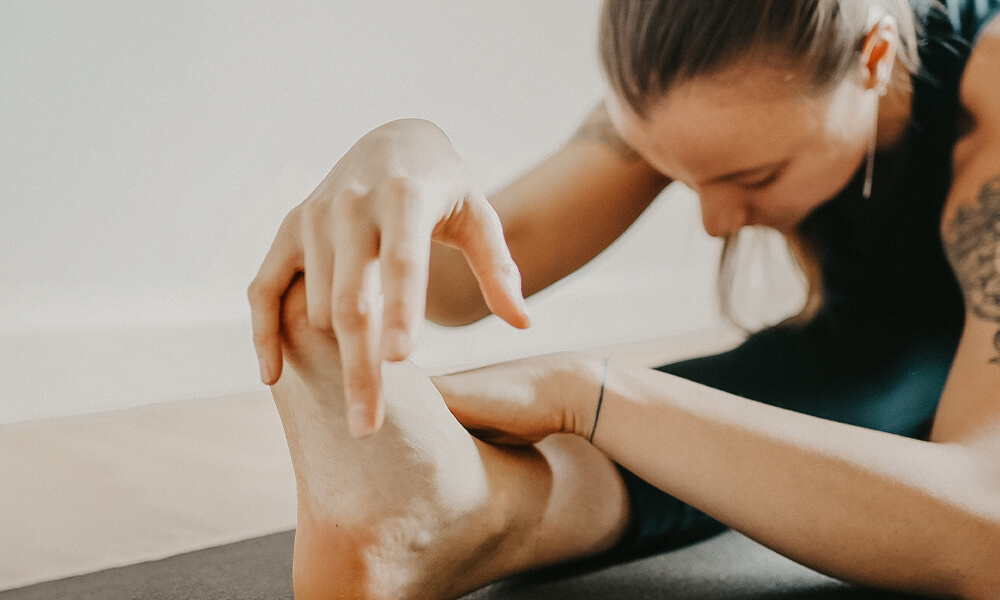
How is Yoga Nidra Different from Other Styles of Yoga and Meditation?
Come on, is part of you at least a little skeptical? How can guided meditation (read: intermittent napping) help a person achieve all these benefits? What about “no pain, no gain” and all that? What about your meditation teacher who says that we must stay alert for it to work?
Yoga Nidra is different and it’s precisely that difference that makes it so powerful.
In traditional forms of yoga, practitioners gain greater awareness by moving and stretching their body and breath. In Yoga Nidra, however, a person gains greater awareness by simply maintaining a neutral attention on any part of their being which may include their body.
Unlike most forms of meditation, including seated meditation, guided meditations, and even sleep meditations, Yoga Nidra does not require you to focus your mind, memorize and repeat mantras, or even eliminate thoughts. Instead, your only job is to relax and go on the journey.
Many other sleep meditations use elaborate visualizations to help you sleep. While some styles of Yoga Nidra may also employ visualizations, the main objective of Yoga Nidra is to invite you to simply welcome, recognize, and witness any object (anything you can be aware of) that presents itself in your field of attention. This helps you to begin to identify less with what you’re witnessing and more as the witness itself. The witness is also the part of you that is already whole and complete.
Yoga Nidra is the perfect practice for people who feel their minds are too busy or too scattered for meditation because with Yoga Nidra, a person doesn’t need to focus or eliminate thoughts, but rather to simply witness them.
The Practice of Non-Effort
It’s important to remember that in yoga, meditation, and wellness, there are many pathways that lead in the same direction, some which involve effort and others that do not. Yoga Nidra follows the pathway of non-effort so instead of moving or stretching your body and breathing consciously, your primary job in Yoga Nidra is to close your eyes, relax and simply observe.
If you’re a type-AAA personality, always pushing your limits, and feel like you’re being lazy unless you’re doing something, it’s likely that you understand how difficult it is to not be doing anything “productive,” and why it’s considered a practice to learn a positive relationship to rest.
If you have an aversion to feeling lazy, and feel as though preparing for good sleep, or maybe even sleep itself is in some way lazy, perhaps it’s no wonder that you have a skewed relationship with sleep.
And come on, sleep deprivation isn’t going to give you the advantage you desire. Instead, consider that one of the best ways to contribute to the world is to present it with a well-rested, calm, and nonreactive version of yourself.

How a Yoga Nidra Practice Helps You Fall Asleep
If you’re typically asleep before your head hits the pillow, it’s likely that you are suffering some level of sleep deprivation. Likewise, if it takes you longer than 30 minutes to get to sleep, something deeper might be at play.
It’s normal for people to take 15–25 minutes to enter a sleeping state. The duration of a Yoga Nidra for Sleep practice (usually 15–45 min.) allows a person the adequate time necessary to fall asleep and allows them to rest, knowing that they are following the proper pathway toward sleep.
Yoga Nidra in general, but in particular Yoga Nidra for Sleep, helps people sleep thanks to two of its defining elements: systematized relaxation and layered and focused awareness.
Realted>>> Take my Yoga Nidra online Training
In Yoga Nidra for Sleep, a practitioner gains greater awareness while simultaneously and systematically relaxing their body as the facilitator leads them through the process of a body scan, allowing them to welcome, recognize, and simply witness each body part and to relax. As the practice continues, practitioners are also invited to simply witness other objects, such as emotions, thoughts, beliefs, etc.
Just like counting sheep, this process of layered and focused awareness helps a person divert their focus and energy away from worries of the day and instead leads it toward something simple, singular, and safe.
The grounding and relaxing nature of Yoga Nidra gives the nervous system the all-clear to prepare for sleep and gives practitioners a relaxed feeling of safety. It also helps to deactivate the frontal lobe, the busy part of your brain used for analysis which, when overly active, stimulates stress hormones in the brain, causing excitement, anxiety, or worry.
The Yoga Nidra practice helps a person transition from hyperfrontality, being overly active in the frontal lobe of the brain, to hypofrontality, switching the analysis part of your brain off, and allowing that busy analysis energy to dissipate and prepare for sleep.
How Yoga Nidra for Sleep Improves Sleep Quality
Adding Yoga Nidra for Sleep as part of a bedtime routine improves regular sleep hygiene which leads to better overall sleep. Developing healthy sleep is sort of like developing a healthy microbiome in your gut.
In a similar way that taking antibiotics can wipe out the healthy flora in your gut, healthy sleep patterns can also get wiped out by dramatic changes in your circadian rhythm such as traveling to a radically different time zone, having either a singular or reoccurring stressful or traumatic experiences, or even pulling an “all-nighter.”
Luckily, in the same way that you can slowly rebuild your healthy gut flora, you can also re-establish your healthy sleep patterns. Yoga Nidra for Sleep is like a probiotic for your sleep. And just like a probiotic, depending on the level of the problem, sometimes it may take a little while to re-establish good sleeping patterns.
Yoga Nidra for Sleep Helps You Get to Sleep Faster
Yoga Nidra for Sleep also helps with sleep onset, meaning it helps you get to sleep faster or, rather, in the appropriate amount of time it takes to fall asleep. It also helps to curb anxiety about not sleeping, a total nonstarter for sleep. Falling asleep without too much trouble and in the appropriate amount of time allows you to take advantage of those wonderful and helpful early stages of sleep which I’ll discuss further on.
Because energy moves toward where you focus, Yoga Nidra for Sleep helps you to direct your energy toward sleeping by establishing sleep as a deliberate goal.
At the risk of sounding overly obvious, Yoga Nidra for Sleep helps you to clarify in both your conscious and unconscious mind that your goal at that moment is to sleep, not to unwittingly worry about the lack of sleep, or anything else for that matter. Ironically, sometimes the worry about having trouble falling asleep at night can follow us into sleep giving us less restful sleep.
So, by slipping into easy sleep with Yoga Nidra for Sleep, you can establish a pattern of regular and good sleep that soon develops into a normal pattern.

The Benefits of Yoga Nidra for Sleep
Yoga Nidra for Sleep is a simple, approachable, and inexpensive way to train you to create a lifestyle of good sleep. It also helps to familiarize you with the sometimes unfamiliar realm of rest. Like anything else, rest is a practice that a person can perform either well or poorly and Yoga Nidra for Sleep provides a simple way to practice.
Plus, we all need a way to switch off our brains that doesn’t involve mindlessly streaming movies or scrolling social media. Yoga Nidra for Sleep empowers a person to know exactly what they need to do to develop good sleep hygiene as well as understand and execute the appropriate time it takes to enter a sleep state.

Understanding the Science Behind Yoga Nidra for Sleep
You might appreciate learning the science behind how Yoga Nidra for Sleep works. To understand what’s going on behind the scenes, let’s take a look at what the brain is doing during Yoga Nidra practice and sleep, the role of stress in sleep, and how Yoga Nidra for Sleep helps a person enjoy all the different and necessary stages of sleep so we wake feeling rested, clear, and alert.
The Brain: A Perception Problem
Ever feel like you can’t switch off your brain? Well, you can’t! Our brains are thinking machines, and we never really “turn off” our brains, even when we sleep. Since we cannot turn our brains off, Yoga Nidra engages the brain by giving it something simple and singular to focus on, such as the many parts of the body during a body scan, so that the brain doesn’t inadvertently focus on things that might cause anxiety or stress.
In Yoga Nidra practice, we train our brain, even momentarily, to perceive stimuli neutrally as information rather than needing to assign a meaning to it. Then we can learn to respond rather than react to information, both in the moment, and also in our daily life.
It may seem weird, but our brain doesn’t actually distinguish well between absolute and perceived reality.
According to neuroscientists, our brain acts more like a filter and processor of information and variables than a harbinger of absolute reality.
Rather than perceiving absolute reality, what your brain does is gather information, attempt to organize it based on previous or similar information, then categorize and make a meaning about it.
Realted>>> Take my Yoga Nidra online Training
Also, your brain isn’t very good at distinguishing between the information it gathers in daily life, on a screen, or as thoughts in your head. Regardless of the source from which your brain receives the information, it pumps the same chemicals into your body.
So, when you are trying to sleep and you lie there simply rehashing the stress of the day or rehearsing what stressful events might happen tomorrow, your brain, unable to make the distinction between what is real and what is perceived, begins pumping out the same stress hormones into your body that are designed precisely to PREVENT you from sleeping, and instead to get up and do something. No wonder it’s hard to sleep.
Brain waves
Brainwaves are rhythmic patterns of brain activity, that involves neurons interacting in a similar way. The activity is strong enough to be detected outside of the brain with technology such as an EEG machine (electroencephalography).
There are 5 brain wave states, which differ based on frequency machine, and which could be loosely characterized as the following:
- Gamma—heightened awareness
- Beta—alert consciousness and problem-solving
- Alpha—relaxed reflection
- Theta—meditation, creativity, daydreaming (the Nidra state)
- Delta—deep sleep
Just like downshifting the transmission of a car, Yoga Nidra can help a person to manually downshift their brain from heightened mental arousal (Gamma or Beta states characterized by stress or having a busy mind) to the Alpha, Theta, and even Delta, states of ease, creativity, rest, and deep sleep.
The more a person practices downshifting through practices like Yoga Nidra, the more natural and easy it becomes for the brain to slip into the stages that lead to rest and sleep. It’s like creating a well-worn path to the land of ease and relaxation for your brain.
Stress & Relaxation
Naturally, stress is a nonstarter for sleep. But what world-renowned psychiatrist and behavioral therapist Joseph Wolpe discovered through his groundbreaking research on systematic desensitization was that a person cannot feel stress and relaxation at the same time (Joseph Wolpe and Arnold Lazarus, 1996).
That might seem obvious, but stay with me! What he explored is that, as a person becomes trained to regularly enter a state of deep relaxation, when information arises which would normally cause stress for that individual, in a state of deep relaxation, they can learn to simply witness it as neutral information rather than reacting with a stress response.
Yoga Nidra benefits a person in precisely the same way. Instead of instantly reacting to information that comes into a person’s mind, through a process of systematized relaxation and layered awareness, it helps a person to enter a deeply calm state and see any thoughts, perceptions, or experiences merely as information, rather than as something to react to. This reliably helps a person to feel less stress, both in relaxed and waking states. Less stress overall = better rest and better sleep.

Stages of Restful Sleep
Some people who suffer with sleep issues have a hard time getting to sleep, while others have a hard time staying asleep. It’s also important to remember that sleep is not a monolithic thing; it’s not as if you’re either asleep or not asleep.
During sleep, a person experiences repeating sleep cycles every 90 minutes or so; cycles which include both REM sleep (rapid eye movement sleep) in which dreaming occurs, and NREM (non-REM sleep) in which deep sleep occurs without dreams.
Though both sleep cycles are essential for a good night’s rest, the distribution of REM and N-REM sleep is not equal. There is a higher proportion of REM sleep as sleeping progresses, about 4 times total in a 7-hour sleep. (Mallick, Birendra N.; Pandi-Perumal, S. R.; McCarley, Robert W.; Morrison, Adrian R. (2011-07-14).
But here’s the rub: the rhythm of your sleep cycles is not based upon when you go to sleep, but rather upon your circadian rhythm, meaning your body’s internal cycle. That means that if you stay up later than normal or have sleep issues, you essentially skip over those first stages of sleep instead of starting them when your head finally hits the pillow.
So, to get a good and restful sleep, a person must not only get the right amount of sleep, but also the right proportion of REM and N-REM sleep.
This makes a strong case for developing a healthy and consistent bedtime routine which allows time to wind down and enter into a good sleep at the same time every day. Yoga Nidra for Sleep is a skilful element in any bedtime routine, one that can help you train your circadian rhythm to allow you to fall into a regular and restful sleep.
How to Incorporate Yoga Nidra into Your Bedtime Routine
Oftentimes at the end of a long day, all we want to do is veg out in front of the TV, scroll through social media, or browse the web. Ironically, not only do these activities not provide the rest we desire, but actually have the exact opposite effect—they stimulate us and prevent us from getting good sleep.
Instead of spending a few hours in front of the TV or other screens, practicing a healthy bedtime routine is both enjoyable and prepares you for sleeping like a champ. Creating a healthy routine and practicing good sleep hygiene are essential for continuous good sleep.
Realted>>> Take my Yoga Nidra online Training
Consider that the process of falling asleep begins a few hours before sleep. Here are a few suggestions for a pre-sleep routine, one that will truly nourish you and help you achieve regular and nourishing sleep.
Finish eating and drinking 2–3 hours before bed.
It takes a lot of energy to digest your food, so not eating a few hours before bed will help you avoid being up in the night feeling like your heart is thumping in your gut as it attempts to digest the 5-pound burrito you ate 10 minutes before bed, or worse, feeling indigestion or an upset stomach during the night. Going to bed a few hours after you’ve eaten will also help you stay asleep because you won’t have other physical sensations rousing you from sleep.
Plus, nobody wants to be woken up in the middle of the night either with the need to get a drink or to go to the bathroom, so hydrate well during the day and avoid drinking too much water right before bed.
Also, alcohol tends to disrupt sleep for many people, so keep this in mind as you’re choosing whether or not to drink before going to bed.
Avoid Work, Big Conversations, and TV
You want to allow your mind plenty of time to relax before bed so avoid doing work, having stimulating conversations, and watching TV at least 2 hours before bed. These activities can switch a person’s mind from prepping for sleep mode into working or processing mode.
You might be thinking, “BORING!” That’s exactly the point, we are consciously avoiding stimulation. But rather than boring, think of it as resting and winding down time. Reframe it as self-care.
“Run Away From the (Blue) Light, Carol Ann!”
Devices such as screens on phones, computers, and TVs emit blue light, a color in the visible light spectrum which, according to Harvard Medical School, can suppress the secretion of melatonin, the hormone that plays an important role in sleep. Melatonin tells your body that it’s time for sleep.
Blue light, also present in earlier daytime light, suggests to the body that it’s still daytime and therefore not time to sleep which confuses the body’s circadian rhythm.
Instead of vegging out with a movie, scrolling mindlessly on social media, or reading online, activities that risk high exposure to blue light, a person would do well to do some light reading with an actual book. Remember those things? As far as content, try reading light fiction, something that you can easily put down and pick up any time without worrying that you’re going to miss anything too exciting.
There are some useful apps that you can install on your phone and computer, such as f.lux, which help to filter out blue light before you’re scheduled to sleep. But filter or not, it’s better to avoid screens altogether at least an hour before bed.
Relaxing Before Bed
In addition to reading, activities a person can do before bed that promote rest and sleep might include taking a warm bath with dim lights, listening to soft music, coloring or drawing, or doing puzzles.
Hands down, the best practice to prepare for bed is meditation, especially the most relaxing form of meditation of them all, Yoga Nidra for Sleep.
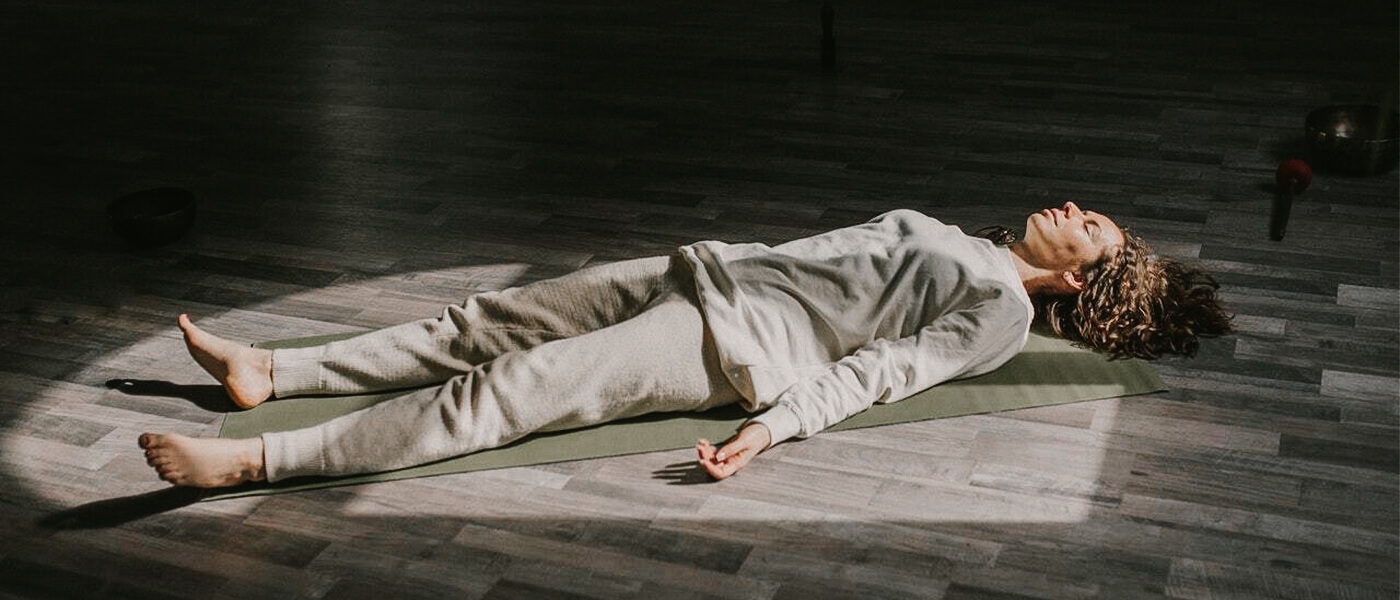
Yoga Nidra for Sleep: The Grand Finale
Plan your bedtime routine so that you can finish with a Yoga Nidra for Sleep practice to either take you right up to sleep or actually put you to sleep. Even though Yoga Nidra for Sleep is itself designed to put you into a very relaxed state, you can improve the results by beginning your Yoga Nidra practice with a neutral or relaxed state of mind, such as just after you’ve taken a warm bath and put on your PJs.
One of the best things about using Yoga Nidra for Sleep in your bedtime routine is that it serves as a deliberate, dedicated, and measured moment for that essential transition from waking to sleeping.
You may choose whether you would like to practice Yoga Nidra in bed to fall asleep, or whether you prefer to practice it lying on a yoga mat or rug on the floor and then transition to bed after the practice. I’ll go into more exact details about the specifics of how to prepare yourself for a relaxing and effective Yoga Nidra practice in a bit.
Why Adequate Sleep Is Crucial
We all know what it feels like to get inadequate sleep—we get irritable, our brain feels like mush, and we can’t muster the energy to do even the most basic things in our life. Many important things in our life suffer as the result of poor sleep, including our work, our relationships, and even our outlook on daily life.
By contrast, when you’re well rested thanks to regular, solid sleep, you have tons of energy, your mind is clear and quick, you feel creative, optimistic, and appreciate life more. Plus, your relationships improve because frankly you’re more pleasant to be around.
Poor Sleep: A Symptom of Other Problems
Sometimes, poor sleep is a symptom of other problems resulting from diet, lifestyle, stress, hormones, and perhaps the state of our mental health. Imbalances in these areas cause the nervous system to get stuck in its sympathetic mode of fight or flight instead of the parasympathetic nervous system mode necessary for good and regular sleep.
When our bodies and minds lack sufficient nutrition, hydration, exercise, and rest, that imbalance sometimes manifests in an inability to get sufficient sleep
Realted>>> Take my Yoga Nidra online Training
.
In fact, sleep and mental health are very closely related so having poor sleep could be an indication that a person might be experiencing anxiety, depression, or bipolar disorder (Scott, A. J., Webb, T. L., & Rowse, G. (2017).
Unfortunately, changes in hormones, such as in menopause or perimenopause, can also disrupt a woman’s sleep.
The Caffeine Culprit
There’s no easy way to say it so I’ll just come out with it … your caffeine is harshing your mellowness. Adenosine is a chemical that promotes sleep. All day, your body steadily and slowly accumulates this chemical which eventually tops out and tells your body it’s time to sleep.
Caffeine blocks adenosine receptors and with the lack of adenosine in your system, you feel awake and alert. But when the caffeine wears off, you now have massive buildup of adenosine which dumps suddenly into your system, hitting you with the dreaded caffeine crash which may have you running for either a siesta, sugar, or worse, more caffeine.
Even though a person may feel minimally affected by caffeine and even able to fall asleep fine, caffeine can stay in a person’s system for up to 72 hours and can disturb their sleep cycles, inhibiting them from completing sleep cycles and entering into deep sleep.
The Problem with Sleeping Pills
What’s the big deal… I can just pop a sleeping pill to help me slip into sleep, right? Sure, sleeping pills can help people either get to sleep or stay asleep but two big problems with sleeping pills are that many of them are addictive and people can build a tolerance toward them so they lose their effectiveness.
What’s a person got to do to get some good sleep around here!? If only there were a natural way to help someone get sleep …
Here’s where our hero Yoga Nidra comes in to save the day. Yoga Nidra offers a simple non pharmacological, non addictive approach to getting kick-ass sleep and the side effects are as good as the sleep itself.
As you’re hopping along the Farmers Market on a Saturday morning after a great night’s rest, zombies with bloodshot eyes will stop and ask what drug you’re on and where they can buy some because they want some of your zip. Tell them about Yoga Nidra, that the first dose is free but they know where to get more and to tell their friends.
Health Problems Resulting From Sleep Disorders
Sleep disorders are not only disruptive, but they can also present a greater risk for both serious health problems including the biggest health problem of them all—death (Datta, K., Tripathi, M. & Mallick, H.N. 2017).
Sleep deprivation can also impair a person’s mental state, similar to the effect of drinking several alcoholic beverages and can therefore result in related accidents. Long-term results of sleep disorders can also include hypertension, depression, obesity, diabetes, stroke, and heart attack. A good night’s rest should be regarded as a critical component of health and less of something that is nice to get when you can.
Can Yoga Nidra Help with Sleep Disorders?
Around 1 in 3 adults suffer from some sort of sleep disorder which includes acute or chronic problems with sleep. Common sleep disorders are insomnia, sleep apnea, narcolepsy, and restless leg syndrome (RLS). Yoga Nidra for Sleep is an effective way of helping you manage symptoms of mild and serious sleeping problems, including sleep disorders, as well as regulating your sleep to eliminate them altogether.
Yoga Nidra for Sleep can help to eliminate many of the root causes of mild or chronic sleeping problems. First, Yoga Nidra for Sleep helps to reduce stress, thereby improving a person’s relationship with rest.
Optimal wellness demonstrates a balanced relationship between rest and activity. For a society that values productivity and activity over rest, it’s no wonder that we lose our ability to rest and our sleep suffers.
Practicing Yoga Nidra for Sleep also helps you feel more rested during the day which helps to eliminate chronic sleepiness during the day, a problem that can contribute to sleep disorders such as narcolepsy.
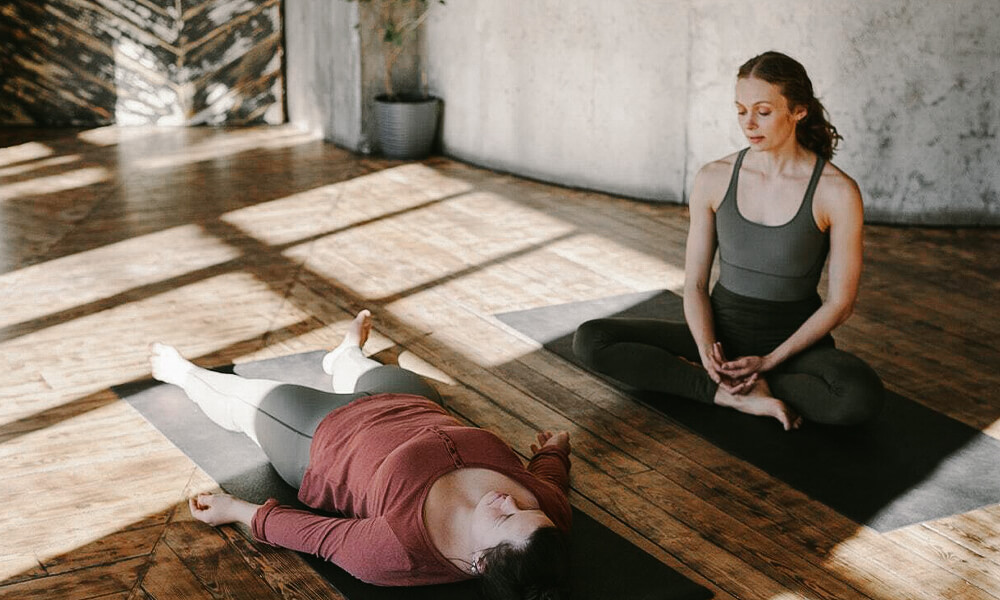
Combining Traditional Yoga Poses with Yoga Nidra for Sleep Apnea
Sleep apnea is a relatively common condition where a person’s breath starts and stops periodically during sleep, causing disruption in sleep and preventing a person from getting deeper sleep. CPAP machines (or constant positive airway pressure) open your lungs and help people breathe while sleeping.
According to many studies, performing yoga poses is very beneficial in the treatment of obstructive sleep apnea (Wong, J. K., Shapiro, S. L., Ross, A., & Schwartz, G. E. 2018).
Practicing some deep breaths (or pranayama, the ancient practice of yogic breathing), as well as breathing deeply during yoga poses helps to open the pathway of the lungs. Poses that may help open the lungs are gentle and supported spinal extensions (back bends), such as bridge or support bridge.
Realted>>> Take my Yoga Nidra online Training
Other poses which help are twists, standing poses, and poses that release tension around the neck and shoulders. As with all physical exercise, you may wish to consult your doctor before practicing poses.
Additionally, practicing yoga poses prior to Yoga Nidra for Sleep may help a person reach a deeper meditative state. This all contributes to a better balance in body, mind, and spirit and can contribute to the conditions for better sleep.
Yoga Nidra for Insomnia
One of the most common and pernicious sleep disorders is insomnia. According to The Cleveland Clinic, one of the top hospitals in the U.S., about 30% of adults worldwide have insomnia symptoms and 10% of all adults have an insomnia severity that meets the criteria to be considered as having a full-blown insomnia disorder.
Yoga has been found to help improve the quality of sleep and to minimize the symptoms of insomnia with chronic insomnia (Ong, J. C., Shapiro, S. L., Manber, R., Segal, Z. V., Wynne-Edwards, K. E., & Gill, S. 2011). Yoga Nidra can also contribute to a healthy sleep routine to help people with either insomnia symptoms or insomnia itself.
Understanding Insomnia
Sleep Onset Insomnia is characterized by having problems getting to sleep. Other forms of insomnia include staying asleep, and getting back to sleep. People who suffer with insomnia often feel chronic tiredness, mental fog, and moodiness throughout the day as a result of a lack of regular, healthy sleep.
Some of the factors contributing to insomnia are drinking too much alcohol or caffeine, uncomfortable or poor sleep conditions such as light in the room, uncomfortable bed, jet lag, shift work, and mental health conditions such as depression and anxiety.
How Yoga Nidra Helps with Insomnia
The good news is that humans are adaptable. If you’re suffering from insomnia, it might be a wake up call (work with me) to make some lifestyle changes including examining your diet, exercise, mental relaxation such as meditation, as well as good and regular sleep hygiene.
Yoga Nidra for sleep helps retrain you back into greater wellness which includes more healthy sleep patterns. Even scientists say so—some excellent scientific studies have been done which suggest that Yoga Nidra can be used as a considerable support for people who suffer from insomnia (Datta, K., Tripathi, M. & Mallick, H.N. 2017).
Not only is Yoga Nidra a simple, effective, and completely natural way to give your body and mind a remedy for stress, it can also act as a keystone element to a healthy bedtime routine. Similarly, it may help to illuminate factors which could be contributing to poor sleep.
There’s nothing worse than lying wide awake at night with anxiety about the sleep you’re not getting, stress which only compounds the problem. Yoga Nidra can also help to eliminate anxiety about not sleeping because even if you don’t enter dreamland while practicing Yoga Nidra, it nonetheless helps you to learn to witness the experience neutrally, without emotion.
Plus, it also helps you to rest assured knowing that even if you’re not sleeping, you’re nonetheless receiving concentrated rest. Yoga Nidra practitioners often report that Yoga Nidra feels like 4X the rest you’d get with a nap. Practicing 30 minutes of Yoga Nidra, even if you stay awake, will likely still help you feel quite rested.
Incorporating Yoga Nidra into Your Insomnia Treatment Plan
To incorporate Yoga Nidra for Sleep into your insomnia treatment plan, practice it several times a week, if not daily. Different people respond to the practice in different ways so it’s good to experiment to see what works best for you.
Try doing a Yoga Nidra for Sleep practice at different times of the day to see what time works best for you, either during the morning, afternoon, an hour before bed, or right as you go to bed with the hopes of falling asleep. Also, have your Yoga Nidra setup handy in case you wake in the night and have a difficult time sleeping so you can slip out of bed and slip into a Yoga Nidra practice.
You may wish to experiment with different positions, lying down in bed, on the floor, or couch, and possibly even in a seated position. The “correct” way to practice is the way that is right for you.
Depending on when you practice, you may wish to also perform some gentle and relaxing yoga postures like some easy stretching, passive and restorative postures, and gentle twists before doing a Yoga Nidra for Sleep practice.
Some studies have even determined the efficacy of yoga poses to help with insomnia (Jiang, J., Kim, H., & Yang, M. 2017). Generally, if you can’t get back to sleep after 30 minutes it might be a good idea to get out of bed and go lie down somewhere else. This could mean that you have your Yoga Nidra nest set up somewhere other than your bedroom.
How to Practice Yoga Nidra for Sleep
Essential Preparations
To prepare for Yoga Nidra for Sleep, do your best to create an environment that will be conducive to relaxation, one where you will not be disturbed by people, sounds, or pets. I’ve made a door hanger for you that you can put on the outside of the door to alert people, “Shhhh, I’m napping my way to enlightenment.” Click here for your FREE door hanger (enter coupon code YOGITIMES).
You’re welcome. If your pets don’t read, you may need to put them in a different part of the house where they will not be scratching at the door.
Despite your best efforts, distractions may arise nonetheless. Since our primary objective in Yoga Nidra is to merely welcome, recognize, and witness any object that arises in our consciousness. If a distraction does come, treat it like an interesting plot twist in your sleepy drama. Adopt a playful curiosity around the object instead of opposing it.
Simply welcome the experience into your awareness, recognize it for what it is (call the object by name i.e., “sound”), and be the witness and observe it.
While you don’t need any special gear to practice Yoga Nidra, you may wish to place a cushion under the knees. This helps with possible tension in the lower back. A blanket or pillow behind your head is nice and a blanket on top of you keeps you warm.
An eye mask or eye pillow is very useful to help a person relax their nervous system and enter into a deeper relaxation. You may practice Yoga Nidra for Sleep in bed or in a place other than your bed such as the couch or on a yoga mat on the floor or massage table.
Realted>>> Take my Yoga Nidra online Training
Though you may snooze during Yoga Nidra for Sleep, remember that the principal benefit of the practice is to train your nervous system to enter deeper states of relaxation more easily and to become increasingly familiar with the brain wave states associated with sleep such as Theta and Delta. On a deeper more meta level, it’s also to practice learning to merely witness any object with an air of curiosity, identifying less as the object and more as the witness itself.
On the surface, merely witnessing an object may not seem very significant to promote sleep, but the wisdom of this ancient practice asserts that our true nature is one of pure awareness whose most natural way of being is relaxed alertness.
The more we remember and experience our true nature, that of awareness itself, the more we reconnect to the part of us that is already whole. In relationship to our innate wholeness, any part of our being that is out of true can find alignment and coherence and can also find healing, even our sleep.
On another level, Yoga Nidra for Sleep can also help us to redefine our relationship with the problem and help us to see it as an invitation and opportunity to pay greater attention and to wake up to our greater being. I know, perhaps you were hoping that “awakening” might take a different form than insomnia.
Steps to Follow for a Yoga Nidra Session
To begin your Yoga Nidra practice and prepare the way for deep rest, you may wish to start in a seated position and take a deep breath. Then, perhaps do a few gentle yoga postures or easy stretches to release any tension you may experience before you start.
Gentle twists are particularly effective in wringing out the nervous system and preparing you to relax. You may choose to simply do savasana, or corpse pose, and perform a basic meditation which focuses on deep breaths.
Next, arrange yourself in a lying down position (savasana, or corpse pose) where you will be comfortable and will not need to move for up to 45 minutes. Find a position where your whole body can receive deep rest. Again, I suggest lying down on a comfortable surface such as the bed, couch, a massage table, or on a yoga mat with a blanket or two beneath you.
Again give yourself a few deep breaths into and out of the belly with an emphasis on exhalation. This begins the calming process by stimulating the ventral vagus nerve which promotes the parasympathetic nervous system, the chill out part of your nervous system.
Deep breaths into the belly also facilitate energy flow into your lower chakras, promoting ease and feeling of being grounded rather than feeling energy rising, which can sometimes lead to feeling anxious. After a few breaths, allow your breathing to resume to whatever feels easy and natural. For the remainder of the practice, do not use any deliberate breath practices.
As you begin your practice, you may wish to establish your sankalpa. A sankalpa is a positive intention, affirmation, or truth statement. You can choose any positive statement relevant in the present moment such as, “I’m restoring my ability to achieve deep, relaxing, and nourishing sleep,” or “I’m setting the conditions for deep, relaxing, and nourishing sleep.”
While using a sankalpa in this way is completely optional and your Yoga Nidra practice will still benefit you regardless, it does add some powerful and positive programming that can open you up to the possibility of your desired benefit of the practice.
For the duration of the Yoga Nidra for Sleep practice, your only job is to welcome, recognize, and witness the information that filters into and out of your field of attention, whether it arrives via the teacher’s suggestion or if it appears spontaneously in your awareness.
Random objects could be something like thoughts or noises from the next room. Practice allowing the experience to be whatever it is and try not to control it. As long as it feels safe, your only job is lay back and enjoy the ride.
If you feel the urge to move or adjust your position at any time during your practice, try first taking a few seconds to merely welcome, recognize and witness the sensation or urge before reacting to it. If the sensation persists, feel free to mindfully respond by adjusting or changing your position.
Over time, Yoga Nidra will strengthen your ability to respond, rather than react, to life’s events, which can benefit everything from your relationships to the environment at your work and community.

Tips for Making the Most Out of Your Yoga Nidra Session
One of the things you can do to optimize your Yoga Nidra for Sleep session is to be generous with your schedule. If you’re practicing Yoga Nidra during the day, avoid scheduling other events too closely before and after your session, so that you are not stressed to either start or finish the practice.
Use the bathroom before your practice, get a small drink of water, and dim the lighting. Using an eye mask or eye pillow helps to activate your parasympathetic nervous system, which triggers your relaxation response.
Common Mistakes to Avoid When Practicing Yoga Nidra for Sleep
There’s no correct way to do this practice. Eliminate expectations. Relax in Yoga Nidra practice and know that as long as it feels safe, whatever happens during practice is merely something to observe.
You might stay awake, you might fall asleep quickly or experience something between waking and dreaming. It’s all correct. The important thing is to try not to engineer the experience, but rather allow the experience to simply happen and practice witnessing it as it does.
It’s also worth noting that the kind of awareness we experience in Yoga Nidra happens whether you are awake or not. It’s beyond our rational, waking consciousness. Try to let go of analyzing it and just enjoy the ride.
NB. In some rare instances, practices like meditation, including Yoga Nidra, can bring up difficult memories, grief, or trauma, especially if you suffer with post-traumatic stress disorder. If this ever happens for you, and you don’t feel safe while doing any of these practices, the first line of defense is always to take a deep breath.
Realted>>> Take my Yoga Nidra online Training
If something arises for you during a yoga, meditation, or Yoga Nidra practice that doesn’t feel safe, or even something you don’t want to work on in the moment, you are always welcome and encouraged to focus on something else that helps you to feel safe, loved, and happy.
If feelings of being unsafe continue, stop the practice and simply focus on your breath while relaxing your body. If such occurrences continue, you may wish to seek the advice from a licensed mental health professional.
Perhaps you can ask them how to help you incorporate your Yoga Nidra practice into a larger mental health routine.
The Best Yoga Nidra for Sleep
In the same way that there are many different styles of traditional yoga, likewise, there are many different styles of Yoga Nidra, each one varying slightly based on the school of training and personality of the facilitator.
Choosing a Yoga Nidra for Sleep practice that is right for you might be challenging so here are a few things you may wish to look for in a Yoga Nidra for Sleep practice.
One of the first things to consider when choosing a Yoga Nidra for Sleep practice is whether it is designed specifically for sleep or it is just a generic Yoga Nidra practice. Indeed, a generic Yoga Nidra practice will be beneficial to help you achieve deeper rest and greater awareness, but a skilled facilitator and specialized practice can help optimize the practice to focus specifically on the need for better sleep.
A specialized practice will help you focus your efforts on the desired outcome of getting better sleep.
Another factor in choosing a Yoga Nidra for Sleep practice is whether or not you enjoy listening to the facilitator. Within a few seconds of the practice, you may discern whether or not you find the facilitator’s voice pleasing in tone, timber, and timing.
As you begin a Yoga Nidra for Sleep practice, if you’re not jiving with the sound of the recording or the tone of the facilitator, practice welcoming, recognizing, and merely witnessing the experience, using it as another object to help you practice greater awareness. If after a few minutes, you still find it difficult to listen or you’re just getting relaxed, you may opt to respond to that information by searching for a different facilitator or recording.
Recommendations for the Best Yoga Nidra for Sleep
In my 20 years of teaching yoga 15 years of teaching Yoga Nidra, one of the most frequent requests is for a practice that will help people get better sleep. I therefore spent a lot of time designing and recording the perfect Yoga Nidra for Sleep practice, one specifically for this purpose and not just a generic Yoga Nidra practice.
I built this practice with your best sleep in mind, keeping my voice soft, measured, and offering generous pauses to help you feel relaxed and at ease. I engineered the timing and timber of my voice to help you manually downshift your nervous system and descend into your deeper, more relaxed brain wave states.
Also, at the beginning of the practice, I propose a sankalpa, the stated purpose of the practice, specific to the need of achieiving better sleep. This helps you positively program your conscious and unconscious mind to achieve deep, nourishing, and satisfying sleep.
This Yoga Nidra for Sleep practice is perfect for experts and novices alike, regardless of whether or not you have any prior experience with Yoga Nidra, yoga, or meditation.
It’s easy to do; just close your eyes, lay back, and I will guide you through a relaxing and enjoyable experience that allows you to practice setting the conditions for amazing sleep.
Improve Your Sleep With Help From Scott Moore
Getting a good night’s sleep can change your life, and Yoga Nidra can assist. If your sleep problems are difficult to manage, try Yoga Nidra for better health, starting with better sleep.
If you would like one-on-one lessons, coaching, or wish to become a Yoga Nidra facilitator yourself, take my online course. I would love to help you develop a program to help you improve and maintain excellent wellbeing in body, mind, and spirit.
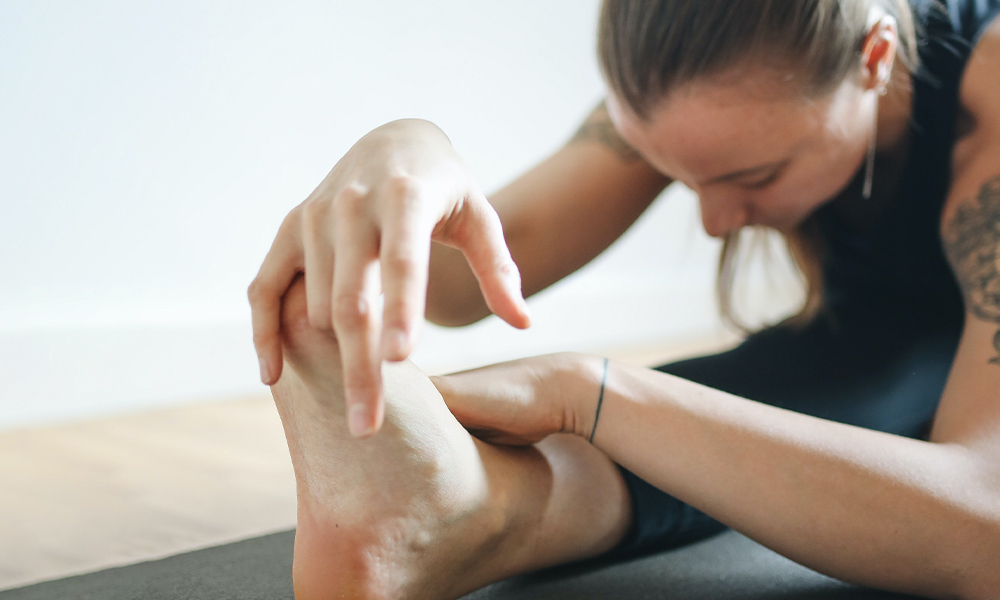
Conclusion
Yoga Nidra for Sleep is a simple and effective practice with many direct and indirect benefits that contribute to incredible sleep. First, Yoga Nidra for sleep helps you develop excellent sleep hygiene.
Also, it allows you a simple way to practice getting into and staying in deeper brainwave states which contribute to getting to sleep faster and staying asleep longer.
Plus, whether you suffer from mild or severe sleep problems, Yoga Nidra for Sleep is very effective at helping you achieve better sleep in a way that is totally natural, non-addictive, and non-pharmacological. It also helps you to receive concentrated rest when you’re suffering the consequences of poor sleeping, whether that’s being up in the middle of the night or slogging through a tired day as the result of not sleeping well.
Finally, as an additional benefit, as with all Yoga Nidra, Yoga Nidra for Sleep helps you to be more responsive and less reactive, more alert and creative in your daily life, and more present to the miracle of every-day life.
Remember, the same way a person can practice yoga asanas to improve strength, balance, calming and flexibility, likewise a person can practice Yoga Nidra to help set the conditions for better sleep.
Establishing a healthy sleep routine is key to getting regular, deep, and nourishing sleep. Yoga Nidra for Sleep is an essential element of any good sleep routine.
Final Thoughts on Yoga Nidra and Sleep
Poor sleep is one of the greatest and wide-spread health problems in the world. Yoga Nidra for Sleep is a simple and effective way of re-establishing and maintaining excellent sleep habits.
Like all practices, the best way to discover the benefits is to give it a try and see it for yourself.
Namaste,
Ommmzzzzzzzzz
Resources
- Wong, J. K., Shapiro, S. L., Ross, A., & Schwartz, G. E. (2018). Impact of yoga on sleep quality: A systematic review and meta-analysis. Sleep Medicine Reviews, 36, 58-68. doi:10.1016/j.smrv.2017.06.001
- Jiang, J., Kim, H., & Yang, M. (2017). Yoga for insomnia: A systematic review and meta-analysis. Sleep Medicine Reviews, 34, 56-65. doi:10.1016/j.smrv.2016.07.005
- Espie, C. A., Rising, R., McEvoy, P. D., Palmer, S., Brown, J. E., & Visser, P. J. (2015). The effect of yoga on sleep quality and psychological well-being in older adults: a randomized controlled trial. Journal of Sleep Research, 24(2), 166-174. doi:10.1111/jsr.12223
- Ong, J. C., Shapiro, S. L., Manber, R., Segal, Z. V., Wynne-Edwards, K. E., & Gill, S. (2011). Yoga for chronic insomnia: Results from a pilot randomized controlled trial. Journal of Clinical Sleep Medicine, 7(4), 41-49. doi:10.5664/jcsm.1280
- Datta, K., Tripathi, M. & Mallick, H.N. Yoga Nidra: An innovative approach for management of chronic insomnia- A case report. Sleep Science Practice 1, 7 (2017). https://doi.org/10.1186/s41606-017-0009-4
- Mallick, Birendra N.; Pandi-Perumal, S. R.; McCarley, Robert W.; Morrison, Adrian R. (2011-07-14). Rapid Eye Movement Sleep: Regulation and Function. Cambridge University Press. ISBN 978-1-139-50378-5..
- (Scott, A. J., Webb, T. L., & Rowse, G. (2017). Does improving sleep lead to better mental health? A protocol for a meta-analytic review of randomised controlled trials. BMJ open, 7(9), e016873.
- https://pubmed.ncbi.nlm.nih.gov/28928187/)
- (Joseph Wolpe and Arnold Lazarus, Behavior Therapy Techniques, (Oxford: Pergamon Press Ltd., 1996), 55-56.)